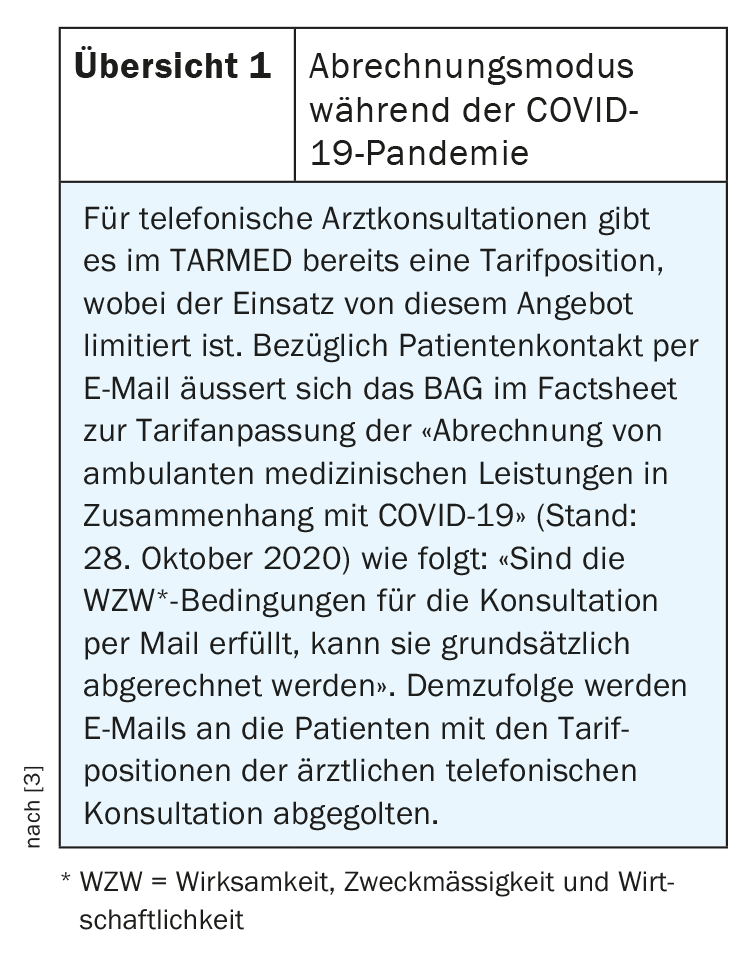During the COVID 19 pandemic, the use of digital services has continued to gain currency. The results of the Digital Health Survey show that demand was already high. The interim evaluation of the eHealth Switzerland 2.0 strategy shows that the promotion of digitization in medicine is an important health policy concern.
The COVID 19 pandemic has further fueled the trend of digitization in healthcare. However, there are still a few hurdles to overcome with regard to the widespread implementation of such services. The billing mode for telephone consultations and patient contacts by e-mail is regulated in TARMED (overview 1) . However, the remuneration for the use of “store and forward” technology, i.e. the time-delayed assessment of patient images and data, is still insufficiently solved. However, issues surrounding digital health innovations are highly topical on the healthcare policy agenda, and efforts are underway to further optimize the framework conditions.

Majority finds digitization in healthcare important
The results of the “Digital Trends Survey 2019” show that there was already a high level of interest in telemedicine services before the Corona crisis. One conclusion of this study is that a majority of the population and the medical profession have a positive attitude toward digital innovations. A total of 494 ambulatory physicians and 2432 members of the public participated in this large-scale survey [1]. 85% of physicians surveyed said that using digital options was important to them, with the greatest interest in online reference tools. Patients are also very interested in digitization. For example, it was found that the choice of doctor’s office is definitely also made depending on the offer of an online appointment. Overall, the public’s interest in digital offerings is greater than that of the medical profession, with automatic notifications of doctor’s appointments or waiting times being among the most frequently expressed patient wishes. According to this survey study, the most common telemedicine service offered is sending photos to the medical professional using a smartphone. In summary, it can be stated that digital offerings can bring great benefits to practice if technical, legal and remuneration-related obstacles can be removed.
Strategy eHealth Switzerland 2.0: interesting interim balance sheet
Increased promotion of digitization in the healthcare sector is one of the declared goals of the federal government and the cantons [1,2]. A key element is the introduction and dissemination of the electronic patient record. In the future, healthcare facilities and healthcare professionals will be digitally networked, will be able to exchange information electronically along the treatment chain, and will be able to use data multiple times. The current version of the “Strategy eHealth Switzerland 2.0” is still valid until 2022 [1,2]. As of the end of June 2020, a report on the current status of implementation has been summarized:
Electronic Patient Dossier (EPD): All measures concerning the introduction of the EPD are in progress (e.g. communication, empowerment, exchange formats, self-declaration of health apps).
Promoting digitization in general: Concrete projects in this regard are being implemented by the federal government and the cantons on an ongoing basis. What has already been implemented, for example: Creation of a new “Digital Transformation” department at the FOPH or recommendations from the federal government and cantons on interoperable EPD supplementary services.
Cybersecurity: Minimum standards for primary systems or strengthening cyber and data security are among the topics that have not yet been sufficiently addressed due to scarce resources.
Interoperability: A need for more interoperability and thus multiple uses of data and infrastructure has been identified. There is room for improvement with regard to the coordination of players in the healthcare system and the use of existing infrastructures, as well as for the setting of recognized standards. The processing of the interoperability strategy can contribute to this.
Literature:
- FMH: “Digital Trends Survey 2019”, www.fmh.ch/files/pdf23/fmh-digital-trends-survey-2019-de.pdf, last accessed 05.11.2020
- Strategy eHealth Switzerland 2.0: www.e-health-suisse.ch/politik-recht/strategische-grundlagen/strategie-ehealth-schweiz.html, last accessed 05.11.2020
- FMH: Fact Sheet: Billing of Medical Services Related to COVID-19 (New Corona Virus), Version 8.0, October 28, 2020, www.fmh.ch/files/pdf23/faq-abrechnung-covid-19.pdf, last accessed Nov. 05, 2020.
HAUSARZT PRAXIS 2021; 16(1): 23











